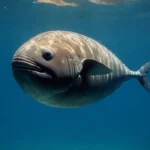The Great White Shark (Carcharodon carcharias): Monarch of the Oceans

In the dark depths of the world’s oceans, a predator reigns supreme with undisputed mastery – the Great White Shark (Carcharodon carcharias). It’s a creature that inspires both fascination and fear, symbolizing the power and mystery of the marine depths. The Great White Shark is a supreme hunter, an apex predator, and one of the most remarkable and fearsome marine animals.
Description and Characteristics
The Great White Shark is one of the largest species of sharks, with an average length of 4-5 meters, although adult specimens can reach sizes of up to 6 meters or even more. Its massive and hydrodynamic body is covered with gray or gray-blue skin, and the underside is often white, hence its common name. A distinctive feature of this shark is its conical snout and impressive face, equipped with long, sharp teeth arranged like knives.
Its large lateral fins provide stability and speed, while the powerful tail propels it rapidly through the ocean waters. Unlike other sharks, the Great White Shark exhibits efficient thermoregulation, being able to maintain a higher body temperature than the surrounding water, allowing it to explore various habitats, from tropical waters to cold ones.
Habitat and Distribution
The Great White Shark can be found in the oceans worldwide, although it prefers areas with moderate temperatures, such as the coasts of California, South Africa, Australia, and the Guadalupe Islands. These areas are frequented by these predators due to the abundant presence of marine mammals, such as seals, sea lions, and other potential prey.
Although they are often associated with ocean depths, Great White Sharks can also be encountered near coastlines, navigating in shallower waters in search of food. However, they prefer deeper waters, where they can hunt more successfully and encounter fewer natural predators.
Diet and Hunting Behavior
With an impressive appetite and formidable hunting ability, the Great White Shark is a ruthless predator. Its main diet consists of marine mammals, such as seals and sea lions, but it also doesn’t hesitate to prey on other creatures like large fish, marine turtles, and other sizable marine animals.
White sharks use smell and electroreception to detect their prey. They can sense even the smallest traces of blood in the surrounding water, easily navigating towards potential food sources. When they find a victim, these sharks attack with astonishing speed, using their sharp and powerful teeth to catch and tear apart their prey.
Conservation and Threats
The Great White Shark faces numerous threats in its natural environment, and the negative impact of human activities on shark populations is considerable. Overfishing, accidental capture in fishing nets, pollution, and the depletion of natural resources are just a few of the challenges facing these magnificent creatures.
In recent decades, awareness of the importance of shark conservation has increased significantly, and efforts to protect these animals have been intensified. Implementing sustainable fishing policies, creating marine reserves, and public education are just a few of the measures adopted to protect shark species, including the Great White Shark.
Fascination and Controversy
The Great White Shark has captivated the imagination of people for centuries, being the subject of numerous literary works, films, and documentaries. The fascination with these creatures has also generated controversy, fueled by rare but dramatic incidents of attacks on humans.
However, it is important to recognize that these incidents are extremely rare compared to the large number of peaceful encounters between humans and sharks. Moreover, many of these attacks result from mistaken identity on the part of the sharks, which confuse humans with their natural prey.
Conclusion
The Great White Shark remains a symbol of the mystery and beauty of nature, as well as a symbol of respect and conservation of the marine environment. While myths and legends surround their existence, it is essential to rely on scientific knowledge and understand the crucial role these creatures play in marine ecosystems. Protecting Great White Sharks and other shark species is essential for maintaining balance in the world’s oceans and conserving marine life diversity for future generations.

















One thought on “The Great White Shark (Carcharodon carcharias): Monarch of the Oceans”